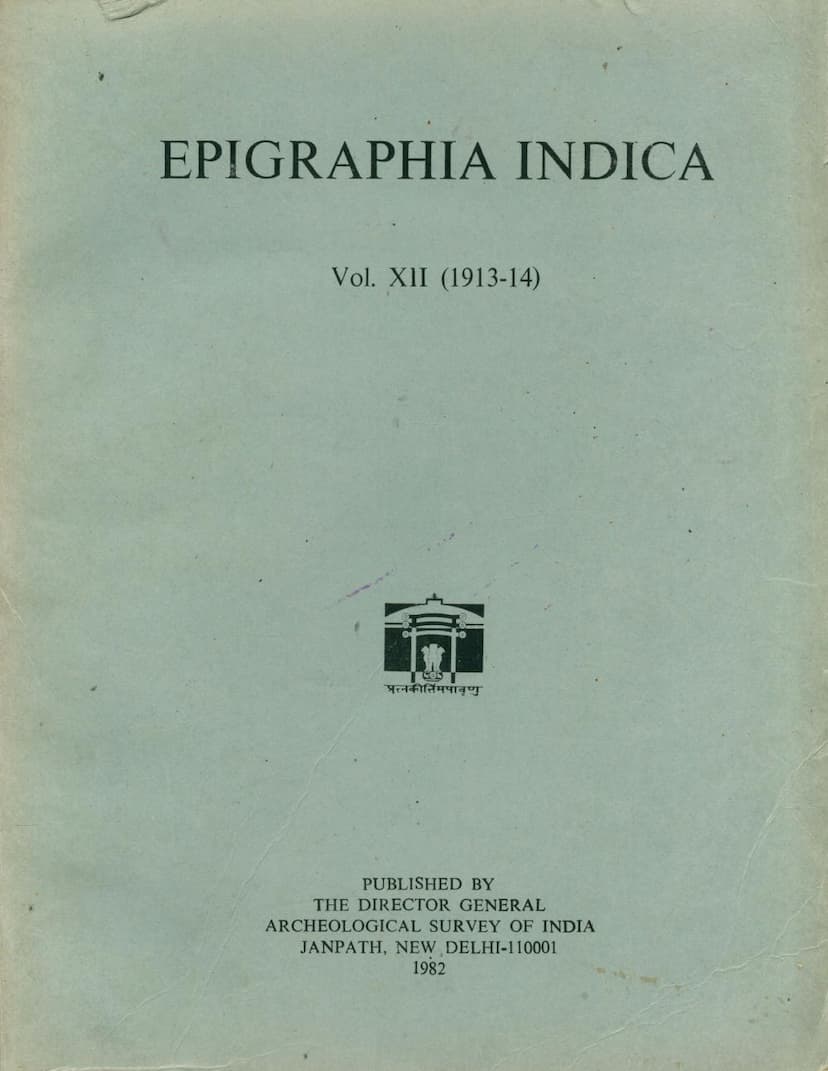Epigraphia Indica Vol 12
Added to library: September 1, 2025

Summary
This document is Volume XII of Epigraphia Indica, published by the Archaeological Survey of India. It contains scholarly articles by various experts, including Sten Konow (who also edited the volume), R. D. Banerji, L. D. Barnett, E. Hultzsch, D. R. Bhandarkar, P. R. Bhandarkar, P. N. Bhattacharya, C. O. Blagden, J. F. Fleet, Y. R. Gupta, Pandit Haraprasad Shastri, Hiba Lal, E. Hultzsch, Sten Konow, Mazumdar, F. E. Pargiter, K. B. Pathak, Sten Konow, Pandit Ramabarna, K. V. Subrahmanya Aiyar, Vinoda Bihari Vidyavinoda, and H. Jacobi.
The volume is a collection of transcriptions, translations, and analyses of various ancient Indian inscriptions found on copper-plates, stone slabs, and pillars. These inscriptions provide valuable insights into the political, social, economic, and religious history of India from approximately the 4th century to the 17th century AD.
Key themes and contents of Volume XII of Epigraphia Indica include:
- Royal Grants and Dynastic Records: Many inscriptions are land grants issued by kings, detailing genealogies, administrative divisions (vishaya, bhukti, mandala, nādu), royal titles, and the religious merits associated with such donations. Several dynasties are covered, including the Eastern Chalukyas (Ammaraja II), the Senas (Lakshmana Sena), the Varmans of East Bengal (Bhojavarmadeva), the Guhilots (Baladitya), the Kalachuris (Buddharaja, Yasahkarnadeva), the Chahamanas (Bhartsivaddha), the Gangas (Vijayaditya), the Pallavas (Narendra Satrumalla), the Kakatiyas (Ganapatideva), the Chalukyas of Kalyani (Vikramaditya VI, Jayasimha II), and the Silaheras (Chhittarajadeva).
- Religious and Cultural Information: Inscriptions shed light on religious practices, including donations to Brahmanas, Buddhist shrines (vihāri), and temples dedicated to Vishnu, Siva, and Buddha. The Rataul plate mentions Baladitya's temple to Murari, and the Mahada plates allude to the worship of Vaidyanatha. The Kudimiyamalai inscription is particularly significant for its content related to ancient Indian music, detailing seven classical ragas with musical notation.
- Historical Geography and Chronology: The inscriptions help in identifying ancient place names with their modern counterparts, understanding administrative divisions, and establishing chronological frameworks for various dynasties and events. The Mandasor inscription of Naravarman provides a crucial early datable inscription using the Malava era.
- Linguistic and Paleographic Analysis: The volume includes detailed discussions on the scripts used in the inscriptions, identifying the types of alphabets (Southern, Northern, Nāgari, Telugu-Kannada, Grantha, Kharoshthi) and their evolution. The analysis of language includes discussions on Sanskrit and Old-Kannarese, noting grammatical inaccuracies and orthographical peculiarities.
- Forgeries and Special Studies: The volume also addresses issues of inscription authenticity, such as the "Spurious Islāmpur plates of the Ganga king Vijayaditya," where the genuineness is contested based on orthographical and historical grounds. Professor Jacobi's contribution on "The Planetary Tables" is a separate scholarly endeavor focused on calculating astronomical positions for historical dating purposes.
- "Pyu" Inscriptions: C. O. Blagden's article discusses the challenges and progress in deciphering "Pyu" inscriptions, highlighting the difficulties due to the limited known vocabulary and the tentative nature of the transliterations.
In essence, Epigraphia Indica, Volume XII, is a foundational text for the study of ancient Indian history and epigraphy, offering detailed scholarly work on a diverse range of inscriptions that illuminate various aspects of India's past.